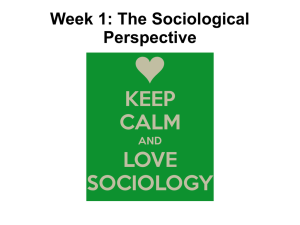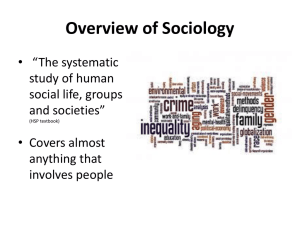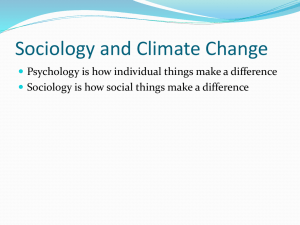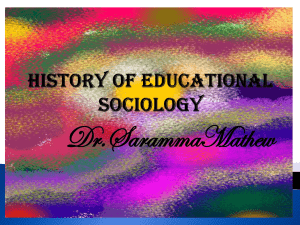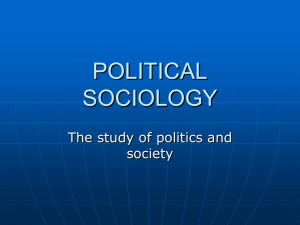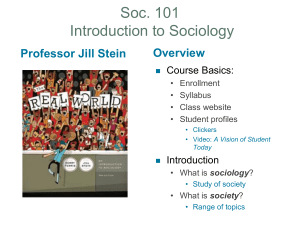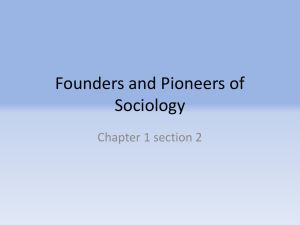An Invitation to Sociology - Cedarburg School District
advertisement
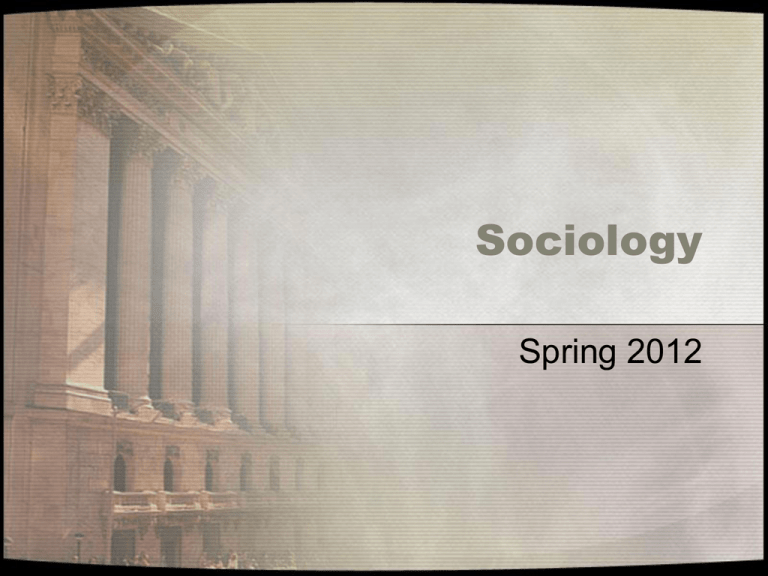
Sociology Spring 2012 Agenda for Day 1 • • • • Seating Chart Ms. Rasmussen Syllabus Exploration of Sociology – Socialization • Student Introductions Ms. Rasmussen (Ras – ma – sin) or Ms. R • Teaches Psychology, AP Psychology & Sociology • Loves animals (especially giraffes) • Getting married in June Syllabus • • • • • • • Course Overview Grading Materials Rules Policies Agenda Parent Signature Exploration of Sociology • Social environment: shapes who we become • Socialization: process of how we learn things – Significant Others: people who greatly influence our lives • Parents, Friends, Etc. • “Big Daddy” video clip Introductions • Who has helped shape you to be the person you are? How so? • State your name and grade – Give an interesting fact about yourself – Then state your significant other and why you choose that person Homework • Reread your syllabus. – Write down any questions you may have. • Due on Friday, January 27th: – Syllabus Signature – Class Materials Agenda • • • • • • Syllabus Questions Warm Up: Goals Overview of the Classroom Warm Up: Introductory Quiz What is Sociology Sociological Perspective The Sociological Perspective Chapter 1 Introduction Quiz (Mark each either “True” or “False”) 1. More U.S. students are killed in school shootings now than 10 or 15 years ago. 2. The earnings of U.S. women have just about caught up with those of U.S. men. 3. More rapists are mentally ill (than not). 4. Most people on welfare are lazy and looking for a handout. They could work if they wanted to. 5. Couples who live together before marriage are usually more satisfied with their marriages than couples who did not live together before marriage. Answers 1. School shootings: FALSE – There were more shootings in the 1990s 2. Earnings of women: FALSE – Gap has narrowed only slightly. Women make only 70% of what men make. 3. Rapists mentally ill: FALSE – Rape is a learned behavior 4. Welfare: FALSE – Most on welfare are children, old, sick, handicapped 5. Cohabitation: FALSE – Opposite is true. What is Sociology? • Individually, list as many words that pop into your head when you hear “sociology”. – 5 minutes • With a partner, group the similar words. Add to your list as more words come to mind – 10 minutes • With a partner, label your groups. – 5 minutes • Individually, define sociology. Sociological Perspective -seeing the broader social context • Also called sociological imagination – Definition: understand human behavior by placing in broader social context – How do groups/societies influence us? • Society: share culture and territory • Social Location – Memberships we have because of our location Sociological Perspective (cont.) The sociological imagination • C. Wright Mills & using our imagination – Sociological imagination – What would a child/person be like if you took it from 1 society when it was a baby & raised it in a completely different type of society? • Avoid a cramped, personal view Sociological Perspective With a partner, discuss the following journal prompt. After your discussion, write down some reasons you and your partner came up with. According to American sociologist C. Wright Mills, people look for relationships between their personal lives and their society. Using the concept of sociological imagination (understanding human behavior by placing it within into broader social context), describe how a runaway “street rat” would explain his reasons for quitting school, leaving his family, and taking to the streets for food, companionship, and shelter. Practicing the Sociological Perspective During other classes you have today/this week, carefully observe the behavior of the instructor(s)/teacher(s) and other students. What patterns do you see in who speaks? What about how people use space? Anything else you notice? Write about what you observe in 1 or more welldeveloped (5+ sentences) paragraphs. Due: Tuesday, January 31st Sociology as a Social Science Important Figures Chapter 1: Sociological Perspective Unit 1: Sociological Perspective & Research Global Context • Globalization: growth of world interdependence • Connections are quite new in human history • Advances in communications & technology • Understand our actions have consequences for others Sociology & Other Sciences • Humans developed science to satisfy basic curiosities – Sociology is a science; studies society and human behavior • Science divided into 2 types; both attempt to find order – Natural sciences: explain & predict natural environments – Social sciences: understand social world through controlled observations Other Social Sciences: • Anthropology – Culture & group beliefs • Economics – Supply & demand • Political Science – Theory of government • Psychology – Human mental & emotional processes • History – Past events • Sociology Read a Down-toEarth Sociology: An Updated Version of the Old Elephant Story on page 7. Partner Activity: Sociology as a Social Science • Compare and contrast sociology to the other social sciences – Anthropology, Economics, Political Science and Psychology • Use p. 6-7 of your textbook. • You do not need to write full sentences; bullet points are fine Goals of Science 1. Explain 2. Make generalizations – Sociologists analyze patterns 3. Predict 3. Must move beyond common sense Origins of Sociology • Ancients answered question on superstition, myth • Sociology appeared in mid-1800’s out of industrial revolution upheaval • American & French Revolutions further challenged tradition • Imperialism led to question of why cultures differ • Began to apply scientific method Practicing the Sociological Perspective During other classes you have today/this week, carefully observe the behavior of the instructor(s)/teacher(s) and other students. What patterns do you see in who speaks? What about how people use space? Anything else you notice? Write about what you observe in 1 or more welldeveloped (5+ sentences) paragraphs. Due: Tuesday, January 31st Important Figures in Sociology • • • • • • • • Auguste Comte Herbert Spencer Karl Marx Èmile Durkheim Max Weber Harriet Martineau Jane Addams W.E.B. DuBois With your assigned group, read about your assigned person, and figure out 2 of the most important ideas presented about them in your text. Your task is to develop a kinesthetic (involving bodily movement) way for your classmates to remember that person. This can take the form of a motion, skit, etc. 1. Auguste Comte – Pages 9-10 2. Herbert Spencer – Page 10 3. Karl Marx – Pages 11 & 29 4. Emile Durkheim – Pages 12-13 & 15 5. Max Weber – Pages 13-14 & 15 6. Harriet Martineau – Page 17 7. Jane Addams – Page 18 8. W.E.B. DuBois – Pages 18-19 Auguste Comte (1798-1857, French) • “Father of sociology” – Positivism • French Revolution led to questions about social order vs. chaos • Originally used term “social physics” – Coined term “sociology” • Practiced “armchair philosophy” Herbert Spencer (1820-1903, British) • Opposed social reform • Introduced Social Darwinism • Wealthy industrialists liked his views – Later discredited • Compared society to an organism Karl Marx (1818-1883, German, exiled in Britain) • Believed in reform • Class conflict = engine of history • Bourgeoisie vs. proletariat • Class conflict would occur – Bourgeoisie overthrown by proletariat – Classless society would develop • Was he a sociologist? Èmile Durkheim (1858-1917, French) • Primary goal sociology as separate academic discipline • 2nd goal show how social forces affect behavior – Famous study on suicide- not just a personal act – Social integration/cohesion • Weaker integration= suicide rates • Emphasized social facts Max Weber Pronounced “Vay-ber” (1864-1920, German) • Said religion force in social change • Protestant ethic – Catholic vs. Protestant viewpoints on being saved • Spirit of capitalism • Tested theory • Argued for value free sociology – Should be objective • Use Verstehen to understand human behavior Harriet Martineau (1802-1876, British) • Translated Comte’s Positive Philosophy into English • Completed a firsthand systematic study of American society in 1830s – Published Society in America – Argued for understanding of women’s lives Jane Addams (1860-1935, American) • Traveled, saw help for poor in London • Co-founded Hull House in Chicago’s slums • Effects of industrialism on lower class – Made legislative gains • Awarded Nobel Peace Prize 1931 W.E.B. DuBois (1868-1963, American) • 1st African American to earn doctorate from Harvard • Racism rampant • Noted issues between African Americans & whites • Connected social analysis to social reform – Founded NAACP Important Figures in Sociology • • • • • • • • Auguste Comte Herbert Spencer Karl Marx Èmile Durkheim Max Weber Harriet Martineau Jane Addams W.E.B. DuBois Closure: Important Figures • With a partner, respond to the following journal prompt. Discuss with your partner and jot down some bullet points. Come up with at least 5 bullet points. Be ready to discuss with the class. Which sociologist do you feel made the greatest impact? Explain why you chose this particular sociologist. Tensions in Sociology Theoretical Perspectives Chapter 1: Sociological Perspective Unit 1: Sociological Perspective & Research Tensions in Sociology • Continued tension between analyzing vs. social reform – Basic/pure sociology • Make discoveries about groups – Clinical sociology • Implementing solutions – Applied sociology • Somewhere in between 2 Recap: Types of Sociology With a partner fill in the chart below. This was covered in lecture and is in your textbook on p. 21-22. Type Basic/Pure Sociology Clinical Sociology Applied Sociology 2-3 Word Description Example Recap: Types of Sociology Type Basic/Pure Sociology 2-3 Word Description Discoveries; Research Example/ Sociologist Comte, Spencer Clinical Sociology Solutions; Reform Marx Applied Sociology Solve Problems; Application DuBois NAACP, Durkheim, Addams Theoretical Perspectives & Levels of Analysis • Theory: general statement • 3 major theories in sociology: – Symbolic interactionism, functional analysis, conflict theory • Macro vs. micro levels of analysis: – Functionalists & conflict are MACRO – Symbolic interactions: MICRO • Need all 3 theories together! Symbolic Interactionism • Society is composed of symbols; used to establish meaning, develop views, communicate – Influenced by Cooley, Thomas & Mead • Studies use of symbols – Mutually understood symbols – Symbols show relationships • Behavior based off meaning giving to symbols • Symbols can change over time Functional Analysis (aka Functionalism, Structural Functionalism) • Society is composed of parts; each has a function that contributes to equilibrium – Pioneered by Comte, Spencer • Integrated whole; like a living organism – Look at structure & function • Robert Merton’s views: – Functions vs. dysfunctions – Manifest vs. latent functions • Latent dysfunctions Conflict Theory • Emphasizes conflict, competition, & change – Opposite of functionalism – Based off of Marxist ideas • Those with power control others – Get the largest share • Many conflicts are about power Perspective Discussion with a partner In recent media reports, many Native American Indian groups have complained that major sports team mascot names such as the Kansas City Chiefs, Washington Red Skins, Atlanta Braves, and Cleveland Indians, are insensitive to their heritage. Using the basic assumptions of symbolic interactionism, defend or condemn the use of American Indian references in team mascot names


